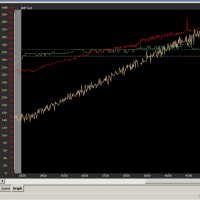With our recent focus on power training and determining FTP, this article by Jennifer Snow Ashbrook has been updated.
We’ve discussed various methods for estimating functional threshold power (FTP) in past articles. In this article, we focus on an alternative method for establishing power-based training zones—the maximal aerobic power (MAP) test. We also provide you with a downloadable profile complete with play-by-play coaching cues and music suggestions, as well as a downloadable spreadsheet to determine your riders’ FTP and calculate their training zones from their MAP test.
The MAP test is a “ramp” test, a testing approach commonly used in Britain and Australia. TrainerRoad, an online cycling training software, has replaced its previously suggested 20-minute and 8-minute FTP tests with this very same ramp test.
The ramp test has some advantages and some disadvantages compared with longer and harder FTP testing protocols.
One advantage is that the test is over pretty quickly and pacing is not an issue like it is with longer FTP tests. However, since the endpoint of this test is “failure,” it’s probably not a good choice for new or deconditioned riders. On the other hand, it’s only the final 2 or 3 minutes that are “hard,” and only the final minute that is “very hard.” If your riders can do an all-out 3-minute test, they should be able to do this one.
The test protocol itself is simple: After a thorough warm-up, riders gradually ramp up power in steps until they cannot sustain the effort any longer. The average power from the final successful minute of the test is used to estimate FTP, which is then used to establish training zones.
Following is a more specific description of the test:
- WARM-UP (15–20 minutes)
- 3–5 minutes of easy riding, self-selected cadence
- 3–5 x 30 on/30 off spin-ups, high cadence, light resistance
- 1–2 minutes easy riding
- 1 minute 85–90 rpm, moderate resistance (RPE 3–4)
- 1 minute easy
- 1 minute 85–90 rpm, slightly more resistance (RPE 5–6)
- 1 minute easy
- 1 minute 85–90 rpm, challenging effort (RPE 7–8)
- 2–3 minutes easy riding
- Begin ramp test
The ramp test should start off at an easy effort at a cadence somewhere between 80 and 95 rpm. The first step of the test should be at a comfortable aerobic pace, about 2–3 on the RPE scale. If you’ve done a previous estimate of FTP, you can begin your ramp test at 50% of that FTP estimate. For example, if your estimated FTP is 150, then start the ramp test at 75 watts. If it’s 220, then start at 110 watts. This first step will determine how many watts you increase for each step, as explained below.
As the test progresses, riders will add resistance to increase power every minute. The goal is to maintain a steady cadence as power is increased for the duration of the test. Power output during each “step” of the ramp test should also be held as steady as possible. You will need a lap or stage button to record an average power output for each minute. Your average power is the most important data of this test!
If riders don’t have a previous FTP test to determine their starting point, use the guidelines below as indicated in the left column; the starting point is based on your riders’ observed power for the first “easy” minute of riding. Once you know the starting point, the right column will indicate how many watts should be added at each stage.
|
Observed power during the first minute of easy riding |
Incremental power increases per stage |
|
< 75 watts |
Increase by 10 watts per minute |
|
75–100 watts |
Increase by 15 watts per minute |
|
100–150 watts |
Increase by 20 watts per minute |
|
150+ watts |
Increase by 25 watts per minute |
When the rider can no longer maintain steady power and/or cadence, their test is completed. The average power from the final successful full minute of the test will be used to estimate FTP.
To use this particular test method successfully, you need a way to monitor and/or record power output as the test progresses. If your bikes are equipped with a stage or lap button, cue your riders to hit the stage button at the beginning of each minute of the ramp test and to write down the average power for the last successful minute of the test. (Make sure to provide pens and paper so they can easily jot that number down as they complete the test—committing it to memory when they are fatigued is a recipe for disappointment.)
When the test is completed, you’ll use the average power from the final successful minute to estimate FTP and establish training zones. FTP is estimated as 75% of your MAP power, and training zones are calculated from there. The MAP test power zone calculator is attached as a spreadsheet to help you make those calculations.
Download the PDF of this MAP test profile:
Be sure to check out these additional articles on FTP training.
You’ve Got Your FTP Number…Now What?
20-Minute FTP Test: Coaching Play by Play



Thank you for this great article, can’t wait to do it with my riders.
I’m noticing that the talk is more about power now and I love it, I use it all the time, we have amazing bikes with power meters , in addition all my riders have got the app on there phone where they have multiple screens including a FTP % screen which shows them what % they are working at according to the zone they are in with the data collected before from doing FTP testing.
Is it still important to do LT testing to find Hr or should we focus on power and then check in with the HR?
I loved this workout! I did not find the spreadsheet to calculate zones – would love to get it!! Thanks!
Another great article to reinforce the importance of introducing/using power measurement/monitoring to indoor cycling. This very detailed description outlines nicely the use of the RAMP test anyone should be able to understand. As an indoor power-certified instructor and an outdoor rider who also trains using power you really nailed this. Great job….
Thanks, Dave! Appreciate the feedback.